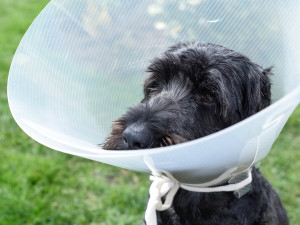7 Signs of Phantom Pregnancy in Dogs
How to deal with this very confusing condition

Share Article
In this article:
Phantom pregnancy dangers Phantom pregnancy symptoms Phantom pregnancy causes Length of phantom pregnancy Diagnosing phantom pregnancies Treating phantom pregnancies Preventing phantom pregnancies FAQs
Despite its name, a phantom pregnancy has nothing to do with ghostly apparitions. Instead, it’s when a female dog starts exhibiting the behavioural and physiological changes of pregnancy without actually being pregnant. In fact, your pup may feel so sure that she is pregnant, she could even start to look pregnant and lactate!
Phantom pregnancy – also referred to as a ‘false pregnancy’ or ‘pseudopregnancy’ is a common condition we vets see with all types of unneutered female dogs. Phantom pregnancies usually occur 6–8 weeks after a season and occur due to changing reproductive hormone levels. Let’s take a closer look at why and how this condition happens, and what we can do to help our poor pooches when they’re going through this confusing time.
Is phantom pregnancy in dogs dangerous?
While a phantom pregnancy may lead to your dog behaving differently and exhibiting a number of confusing symptoms there is usually no harm to your pup and the phantom pregnancy usually passes on its own within a few weeks. Sometimes, however, it can increase the risk of several issues, so it is important to know the symptoms of a phantom pregnancy and what signs to look out for, and to know when treatment may be needed.
7 signs of phantom pregnancy in dogs
Physical symptoms of phantom pregnancy
Nipples and mammary gland enlargement.
Lactation.
Increased weight.
Behavioural symptoms of phantom pregnancy
Mothering items or toys with excessive licking or bringing the item food.
Whining and signs of anxiety, such as increased clinginess or appearing to search for something.
Creating nests, sometimes in the oddest of places!
Aggression, in particular if protecting her nesting area or mothered toys.
Causes of phantom pregnancy in dogs
Hormone imbalances
As the female dog comes out of season, the hormone progesterone starts to decline which prompts another hormone called prolactin to rise. In dogs that produce a phantom pregnancy, this hormone is at a higher level than other non-pregnant bitches, and it is this hormone that causes lactation.
Psychological factors
While not really a psychological issue (phantom pregnancies are a physiological condition), there are some things that can prolong the issue. You as a dog parent can have an impact on the length of time it takes for your pups’ false pregnancy to resolve. Reinforcing any behaviours such as mothering toys can encourage the acts or can provoke the protective aspect and, in turn, can increase risk of aggression. Stimulating the teats with a belly rub or allowing them to lick their teats can increase the milk production, which can also prolong the phantom pregnancy. So, no belly rubs for the time being and, if needed, a body suit can help prevent licking.
Breed predispositions
There have been some studiesopens in new tab into whether certain breeds are more predisposed to having false pregnancies. Breeds such as Labradors, Pomeranians, German Shepherds and Rottweilers have been mentioned as being more likely to experience them but all sizes and breeds of dogs can have a phantom pregnancy. If your dog experiences a phantom pregnancy they are more likely to have one againopens in new tab in the future.
How long does a phantom pregnancy last in dogs?
The length of a phantom pregnancy can vary, but symptoms usually reduce within 2–3 weeks. This is as they progress into the next stage of their oestrous cycle naturally. If lactation begins or behaviours were encouraged then the phantom pregnancy can take longer to resolve. If your dog has had one for more than three weeks, get in touch with your vet for a check-up.
How vets diagnose phantom pregnancy in dogs
Vet can diagnose your dog’s phantom pregnancy through their symptoms and history of when their last season occurred, while also making sure a real pregnancy isn’t being missed. For further evidence however, diagnostics may be needed such as an ultrasound scan or X-ray.
Potential complications of phantom pregnancy in dogs
During a phantom pregnancy the hormones are still raised as if they are pregnant and can cause mammary gland development and lactation, this puts them at risk of mastitis, which is painful and needs medical treatment.
Dogs that have phantom pregnancies may also be at higher risk of a pyometra, which is a serious condition where the uterus becomes infected.
Behavioural changes such as anxiety, mothering behaviours and even aggression can become apparent during a phantom pregnancy. While these behaviours usually return to normal afterwards, there may be some learned behaviours that stick and will need training and or treatment to help.
How to treat your dog’s phantom pregnancy
Distractions
Try to keep your dog distracted and mentally stimulated during their phantom pregnancy. Keeping them occupied can help alleviate their anxiety and reduce mothering behaviours.
Remove the items she’s mothering
Never tell your dog off for their mothering behaviours, it is perfectly normal and if they were pregnant we would encourage it! Instead, while she is distracted, take away the items she is mothering. This may seem unkind but we don’t want her to get protective over these items to the point of aggression. If she is already showing signs of being overprotective, then only remove the items when she is on a walk or is safely elsewhere.
Veterinary intervention
If you notice the phantom pregnancy is going on for more than three weeks then talk to your vet about treatment. Cabergoline is a medication that can be used which reduces the hormone prolactin, which then helps reduce the symptoms of a phantom pregnancy, in particular lactation. Keep an eye out for any signs of redness, heat or bruising around the teats. This can indicate the start of mastitis which needs treatment as it can be very painful and cause further issues.
Can you prevent phantom pregnancy in dogs?
Yes, the only way to prevent a phantom pregnancy is for the dog to be spayed – that way they don’t go through the fluctuating hormones stages of their cycle. Unfortunately, other than this, there is little that can be done to prevent a phantom pregnancy.
Bottom line: phantom pregnancy in dogs
Phantom pregnancies in dogs are a common condition experienced by an unneutered bitch and it can happen to any breed or size of dog. Symptoms can range from mild – such as showing anxiety and whining, mothering items and mammary gland development. Sometimes, more serious signs can arise like lactation or an increase in abdomen size. Some dogs can even seem to have contractions. The phantom pregnancy should pass naturally within a couple of weeks on its own.
Ways to support your dog during this time include using distractions and mental enrichment, and quietly taking the items away if she is mothering toys. Speak to your vet if the phantom pregnancy goes on for longer than three weeks, excessive lactation is occurring or any heat or bruising is noticed around the teats. If you want to prevent your dog from having phantom pregnancies the only way is through neutering. This procedure is done during the point in your dog‘s cycle where reproductive hormones are at their base level. So, you will have to wait until after a phantom pregnancy has passed fully before neutering.
Phantom pregnancies in dogs: frequently asked questions
Can phantom pregnancy happen more than once?
Yes, and if your dog has had a phantom pregnancy in the past they are more likely to have one in the future.
Are younger or older dogs more susceptible to phantom pregnancy?
All ages can have phantom pregnancies, but one studyopens in new tab found more occurrences in younger dogs.
What is persistent phantom pregnancy?
A persistent phantom pregnancy is one that is chronic. This can sometimes occur if the dog was spayed while in a phantom pregnancy or at an inopportune time within her cycle. The symptoms persist and veterinary treatment is needed.
What are the signs of false pregnancy in dogs?
Signs include increased anxiety and whining, along with nesting behaviours or mothering items or toys. Mammary glands can develop and start lactating, as well as an increase in weight.
Resources
Barge, P. J., et al. “Comparative Influence of Breed, Size, Age and Parity on Prevalence of Pseudopregnancy in Bitches.opens in new tab” Indian Journal of Canine Practice, vol. 15, no. 2, Dec. 2023, pp. 131–34.
Razzaque, Waquar, et al. “False Pregnancy in Bitch.opens in new tab” Veterinary World, vol. 1, no. 3, 2008, pp. 92–95.
Root, Amanda L., et al. “Canine Pseudopregnancy: An Evaluation of Prevalence and Current Treatment Protocols in the UK.opens in new tab” BMC Veterinary Research, vol. 14, no. 1, May 2018.
Singh, L. Kipjen, et al. “Canine Pseudopregnancy and Its Treatment Strategies.opens in new tab” Journal of Entomology and Zoological Studies, vol. 6, no. 3, AkiNik Publications, June 2018.

Dr Josephine Corrick, BVMSci, BSc, MRCVS
Dr Josephine Corrick, BVMSci, BSc, MRCVS is a veterinary surgeon based in the south of Scotland where she has been since graduating from the University of Surrey. She enjoys working in general practice treating small animals. Her particular interests include diagnostic imaging and the treatment of wildlife.
Having found a passion for veterinary medicine after doing a degree in Equine Sports Science she still enjoys including horses in her life by spending time with her highland ponies. Alongside her clinical work, she helps run a smallholding caring for rare breed sheep and exploring the Scottish countryside with her young Cocker Spaniel.
Related articles
![A woman walks along the pavement with a dog on a lead close to her]()
How Long Will Your Female Dog Be In Heat?
Take a deep breath and step away from the Always box. We‘ll walk you through it
![a vet in scrubs crouches down in front of a woman with a daschund on their lap]()
How Long After Their Season Should a Dog Be Spayed?
Spaying your female dog is the best choice, but when should you do it?
![Young Man With Retriever Puppy]()
When Should You Spay or Neuter Your Dog?
The research is confusing – here are some guidelines
![black scruffy dog wearing cone recovering from spay surgery]()
Everything You Need to Know About Spaying Or Neutering Your Dog
A vet’s take on why it’s a smart choice
How Much Does It Cost to Spay a Dog in the UK?
The lowdown on spaying costs in the UK





